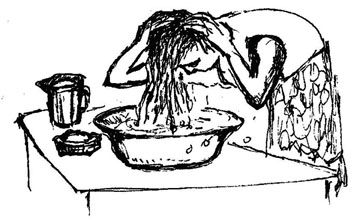3.4.7 Hair hygiene (hair care)
The hair follicles from which the hair grows produce oil from the sebaceous glands that keeps the hair smooth. The scalp (the skin covering the head) also has numerous sweat glands and is a surface for the accumulation of dead skin cells. The oil, sweat and dead cells all add together and can make the hair greasy and look dirty unless you wash it regularly.
Poor hair hygiene could cause dandruff and skin infections such as Tinea capitis (see Figure 3.1). Dandruff is dead skin on the scalp that comes off in tiny flakes when sebaceous glands produce too much oil and accumulates on the scalp.

Head hair is a good harbour for head lice (Pediculus humanus capitis) and nits (eggs of head lice). The head louse is a tiny insect that lives by sucking blood. Children are especially prone to lice infestation. Lice spread from one head to another when there is close contact as in school environments. They make the scalp itchy and are a cause of annoyance, irritation and embarrassment. Shaving of the head hair is possible in cases of heavy lice infestation. Sharing of blades with others, however, should be discouraged.
Hair cleaning (Figure 3.6) is important to ensure it stays clean, healthy and strong.
The recommended procedures for cleaning the hair are:
- Use clean water to wash your hair regularly (at least twice weekly, preferably once every other day) with body soap or shampoo, whichever is available.
- Massage your scalp well. This will remove dead skin cells, excess oil and dirt.
- Rinse well with clear water.
- Conditioner is helpful if you have longer hair as it makes the hair smoother and easier to comb, but hair doesn’t need to have conditioner.
- Use a wide toothed comb for wet hair as it is easier to pull through.
- Dry the hair and the head with a clean towel. Never share a towel with someone else.
- Comb the hair to look beautiful for the day.
3.4.6 Ear hygiene
